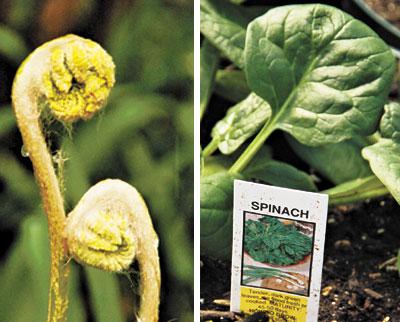Seasons by the Sea: The Promise of Spring

Spring vegetables are on their way, and if you have your own garden perhaps you have already gotten a few sprightly leaves of spinach and lettuce. Of all the seasons, I think spring’s vegetables go the best together. Or perhaps we’re just so grateful they are here?
The corn and tomatoes of summer are certainly a match made in heaven. But by that time we have so many options to choose from at the market and in our gardens, we take the abundance for granted. Winter vegetables also go together marvelously. There’s just something so comforting and earthy about a ragout made from little potatoes, carrots, parsnips, turnips, and leeks.
Spring is promise. And after the winter we have had, I suspect all of us will be relishing the fiddlehead ferns and pea shoots, ramps and scallions, asparagus and morels more than ever.
I just spent a few days in Virginia, which always provides a tantalizing glimpse of what we will get in a few weeks. At Restaurant Eve in Alexandria I had a crispy piece of hake on a bed of quite buttery baby peas, slices of asparagus, and spring onions, so delicious. Stinging nettles were also on the menu, which are apparently a bit difficult to harvest but once tamed in some boiling water taste like spinach.
Asparagus and rhubarb are available now. Rhubarb is excellent in a compote, that is, until strawberries are available to make crisps and pies. James Beard’s recipe for rhubarb compote is as simple and delicious as can be. Add as much sugar as you like, simmer, and serve warm with a dollop of creme fraiche. For a lighter dessert use Greek yogurt. I make big batches of this and freeze it. The first asparagus of the season should be treated like the star it is, simply steamed and topped with a bit of the best butter you can find! Go ahead and spend money on those fancy French butters, but for my money, you can’t beat Kerrygold Irish butter. Once the prices go down and asparagus is plentiful, add it to frittatas, roast it with Parmesan cheese, and stir it into risotto with baby peas.
Fiddlehead ferns are the coiled shoot of ostrich ferns. Their season lasts only a few weeks so keep an eye out for them. They have a bright flavor similar to artichokes and green beans and should be cooked for about five minutes to eliminate any possibility of bitterness. From that point you can serve them cold with a vinaigrette, in a cream sauce, or how about with browned butter and prosciutto? Choose very small ones with a bright green hue, avoid the ones that are yellowing or wilted. Use them as soon as possible, within two days. Scrape off any fuzzy brown scales and trim the ends before cooking.
Morels are mostly found in moist areas around dead or dying elm, sycamore, and ash trees. They are another brief spring treat that goes beautifully with other early vegetables, and especially with eggs. When you see them in the markets (or foraging with an expert ’shroomer) pick each one individually. They can be expensive. Because of the odd spongy surface, it can be hard to clean them. If you must wash them, do it quickly before cooking. Slice them in half lengthwise and give them a brief rinse. The flavor is nutty and meaty, excellent alone or in a cream sauce with Madeira wine and served over veal or chicken.
Dandelion greens (we all have those, don’t we?) can be a bit bitter but are so loaded with vitamins it’s worth incorporating them into your salads or combining with other cooked greens such as kale and bok choy. They have a lot more vitamins A and K, calcium, and iron than broccoli. Naturally, you want to harvest them in areas free of lawn chemicals. If you like chicory, which is popular in Italy sauteed with garlic and red pepper flakes, try the same method with young dandelion greens. Some people even incorporate them into smoothies, as they are believed to have many medicinal properties as well.
Spinach can be picked small for salads or allowed to grow bigger for cooking. Generally, there are two kinds, flat leafed and crinkled, or “savoyed.” In cool spring and fall weather spinach can be quite sweet. It goes very well with olive oil, butter, cream, nutmeg, dill, and ginger. Lemon and garlic and miso are delicious with cooked spinach and a few drops of sesame oil are excellent on a spinach salad. When cooking, keep in mind that it reduces dramatically. Count on approximately 3/4 to 1 cup cooked to each pound of raw spinach.
We are just at the beginning of our growing season, but all of these spring delicacies are appearing in the markets from slightly farther south. Start cooking with them now and those dark days of relentless snow and cold will soon be a distant memory.
Click for recipes
